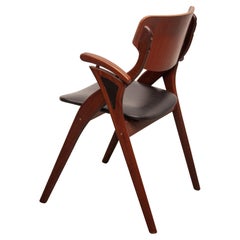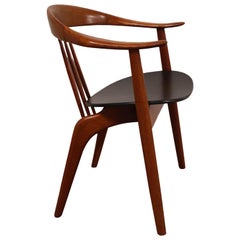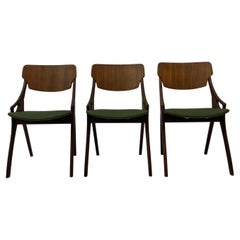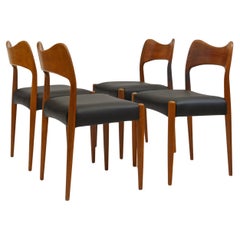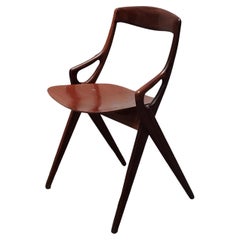Arne Hovmand Olsen Chairs
Throughout the 1950s and ‘60s, Arne Hovmand-Olsen created furnishings that boasted all of the alluring qualities now associated with vintage Scandinavian modern design. The esteemed Danish designer favored high-quality teak, oak and rosewood for his sideboards, chairs and dining tables. Elsewhere, Hovmand-Olsen’s side tables and credenzas feature elegant organic curves and tapered legs, while his graceful armchairs and dining chairs are characterized by slender frames and sculptural seat backs.
From an early age Hovmand-Olsen showed an interest in drawing and an aptitude for design. In 1938, he began his apprenticeship as a cabinetmaker under Peder Olsen Sibast, the founder of Sibast furniture company. Owing largely to the creative direction of Peder’s son, designer Helge Sibast, during the mid-century era, the manufacturer is internationally revered today for its wide range of sleek and collectible modern furniture.
In 1941, Hovmand-Olsen enrolled in a technical school to study furniture design, and opened his own workshop shortly after graduating. He created a range of furnishings for such notable manufacturers as Mogens Kold Møbelfabrik, Elven Geertsen and Jutex. He found success in Denmark, but attained even greater notability when he began selling his work in America.
Mid-century-era design from this region of the world — including objects like Arne Jacobsen’s Egg chair, Alvar Aalto’s undulating Savoy vase and Tapio Wirkkala’s leaf-shaped birch-laminate tray — took off in the States after the Second World War, when Scandinavia’s simple, curvilinear wooden furniture, home goods and textiles suddenly seemed the perfect foil for glass-and-steel skyscrapers.
Hovmand-Olsen closed his workshop during the 1970s. Today his work is widely collected by enthusiasts of mid-century Scandinavian modern furniture.
Find vintage Arne Hovmand-Olsen seating, tables, storage pieces and other furniture on 1stDibs.
1960s Danish Scandinavian Modern Vintage Arne Hovmand Olsen Chairs
Leather, Wood
1960s Danish Mid-Century Modern Vintage Arne Hovmand Olsen Chairs
Leather, Teak
1950s Danish Scandinavian Modern Vintage Arne Hovmand Olsen Chairs
Teak
Mid-19th Century Scandinavian Scandinavian Modern Antique Arne Hovmand Olsen Chairs
Leather, Teak
1950s Danish Scandinavian Modern Vintage Arne Hovmand Olsen Chairs
Teak
1950s Danish Scandinavian Modern Vintage Arne Hovmand Olsen Chairs
Teak
1960s Danish Mid-Century Modern Vintage Arne Hovmand Olsen Chairs
Papercord, Teak
20th Century Danish Mid-Century Modern Arne Hovmand Olsen Chairs
Leather, Walnut
20th Century Danish Scandinavian Modern Arne Hovmand Olsen Chairs
Teak
1970s Danish Mid-Century Modern Vintage Arne Hovmand Olsen Chairs
Upholstery, Teak
1950s Danish Scandinavian Modern Vintage Arne Hovmand Olsen Chairs
Leather, Wood
1960s Danish Mid-Century Modern Vintage Arne Hovmand Olsen Chairs
Fabric, Teak
1960s Danish Mid-Century Modern Vintage Arne Hovmand Olsen Chairs
Teak
Mid-20th Century Danish Mid-Century Modern Arne Hovmand Olsen Chairs
Leather, Teak
1960s Danish Scandinavian Modern Vintage Arne Hovmand Olsen Chairs
Papercord, Mahogany
1950s Danish Mid-Century Modern Vintage Arne Hovmand Olsen Chairs
Teak
1970s Danish Mid-Century Modern Vintage Arne Hovmand Olsen Chairs
Papercord
Mid-20th Century Danish Scandinavian Modern Arne Hovmand Olsen Chairs
Naugahyde, Teak
1950s Danish Scandinavian Modern Vintage Arne Hovmand Olsen Chairs
Brass
1960s Danish Scandinavian Modern Vintage Arne Hovmand Olsen Chairs
Brass
1960s Danish Scandinavian Modern Vintage Arne Hovmand Olsen Chairs
Papercord, Oak
1950s Danish Scandinavian Modern Vintage Arne Hovmand Olsen Chairs
Brass
1950s Danish Scandinavian Modern Vintage Arne Hovmand Olsen Chairs
Brass
Mid-20th Century Danish Scandinavian Modern Arne Hovmand Olsen Chairs
1960s Danish Scandinavian Modern Vintage Arne Hovmand Olsen Chairs
Bouclé, Teak
1950s Danish Mid-Century Modern Vintage Arne Hovmand Olsen Chairs
Papercord, Teak
1960s Danish Mid-Century Modern Vintage Arne Hovmand Olsen Chairs
Wood
1960s Danish Mid-Century Modern Vintage Arne Hovmand Olsen Chairs
Teak
1960s Danish Mid-Century Modern Vintage Arne Hovmand Olsen Chairs
Leather, Faux Leather, Teak
1960s Danish Scandinavian Modern Vintage Arne Hovmand Olsen Chairs
Naugahyde
1950s Danish Mid-Century Modern Vintage Arne Hovmand Olsen Chairs
Teak
1950s Danish Mid-Century Modern Vintage Arne Hovmand Olsen Chairs
Teak, Plywood
1950s Danish Mid-Century Modern Vintage Arne Hovmand Olsen Chairs
Teak
1970s Danish Mid-Century Modern Vintage Arne Hovmand Olsen Chairs
Upholstery, Teak
1950s Mid-Century Modern Vintage Arne Hovmand Olsen Chairs
Leather, Oak, Teak
Mid-20th Century Danish Scandinavian Modern Arne Hovmand Olsen Chairs
Leather, Teak
1960s Danish Mid-Century Modern Vintage Arne Hovmand Olsen Chairs
Leather, Teak
